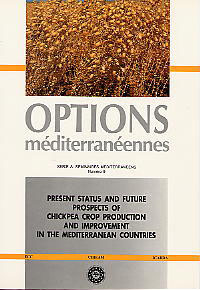| Article précédent | p. 25-34 | Article suivant |
Winter chickpea: problems and potential in the Mediterranean region
The work on breeding of winter chickpea for the past ten years has been reviewed. More than 15.000 germplasm lines were screened and 18 lines were identified as resistant to ascochyta blight. On screening of 4500 lines to cold, 15 lines were found tolerant. All ascochyta blight resistant lines were susceptible to cold and all cold tolerant lines were susceptible to ascochyta blight. Lack of combined resistance in a line to both stresses appears to be the main reason for not cultivating chickpea during winter in the Mediterranean region. More than 800 ascochyta blight and cold tolerant high yielding lines have been bred and made available to national programmes. In each country of the Mediterraean region, superiority of winter chickpea over spring has been proven. National Agricultural Research Systems from eight countries have selected cultivars and released them for winter sowing. The economic analysis indicated that winter-sown chickpea is 60 to 70 percent more profitable than spring chickpea. If all areas in the Mediterranean region are brought under winter chickpea and a modest increase of 500 kg/ha is obtained over spring, the region will benefit by an additional production of 462,500 tones annually.
- [ Afficher ]
- [ Télécharger ]
- [ Exporter la citation ]
Vous pouvez télécharger la citation au format :
- [ Imprimer ]
-
Mots-clés
ANALYSE ECONOMIQUE, ANTHRACNOSE, CICER ARIETINUM, REGION MEDITERRANEENNE, RESISTANCE A LA TEMPERATURE, VARIETECiter cet article
Singh K.B. Winter chickpea: problems and potential in the Mediterranean region. In : Saxena M.C. (ed.), Cubero J.I. (ed.), Wery J. (ed.). Present status and future prospects of chickpea crop production and improvement in the Mediterranean countries. Zaragoza : CIHEAM, 1990. p. 25-34. (Options Méditerranéennes : Série A. Séminaires Méditerranéens; n. 9). Present Status and Future Prospects of Chickpea Crop Production and Improvement in the Mediterranean Countries, 11-13 Jul 1988, Zaragoza (Spain). http://om.ciheam.org/om/pdf/a09/91605007.pdf



